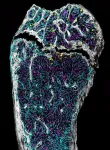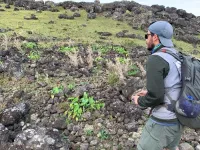(Press-News.org) Researchers at University of California San Diego School of Medicine and international collaborators have led a worldwide, advanced study demonstrating the potential of tirzepatide, known to manage type 2 diabetes, as the first effective drug therapy for obstructive sleep apnea (OSA), a sleep-related disorder characterized by repeated episodes of irregular breathing due to complete or partial blockage of the upper airway.
The results, published in the June 21, 2024 online edition of New England Journal of Medicine, highlight the treatment’s potential to improve the quality of life for millions around the world affected by OSA.
“This study marks a significant milestone in the treatment of OSA, offering a promising new therapeutic option that addresses both respiratory and metabolic complications,” said Atul Malhotra, MD, lead author of the study, professor of medicine at University of California San Diego School of Medicine and director of sleep medicine at UC San Diego Health.
OSA can result in reduced oxygen levels in the blood and can also be associated with an increased risk of cardiovascular complications, such as hypertension and heart disease. Recent studies, also led by Malhotra, suggest that the number of OSA patients worldwide is close to 936 million.
Conducted in two Phase III, double-blinded, randomized, controlled trials, the new study cohort involved 469 participants diagnosed with clinical obesity and living with moderate-to-severe OSA. They were recruited from sites in nine different countries, including the U.S., Australia and Germany. Participants either used or did not use continuous positive airway pressure (CPAP) therapy, the most common sleep apnea treatment which uses a machine to maintain an open airway during sleep, preventing interruptions in breathing. Patients were administered either 10 or 15 mg of the drug by injection or a placebo. The impact of tirzepatide was evaluated over 52 weeks.
Researchers found that tirzepatide led to a significant decrease in the number of breathing interruptions during sleep, a key indicator used to measure the severity of OSA. This improvement was much greater than what was seen in participants that were given a placebo. Importantly, some participants that took the drug reached a point where CPAP therapy might not be necessary. Considerable data suggest that a drug therapy that targets both sleep apnea and obesity is beneficial rather than treating either condition alone.
Additionally, the drug therapy improved other aspects related to OSA, such as reducing the risk factors of cardiovascular diseases and improved body weight. The most common side effect reported was mild stomach issues.
“Historically, treating OSA meant using devices during sleep, like a CPAP machine, to alleviate breathing difficulties and symptoms,” Malhotra said. “However, its effectiveness relies on consistent use. This new drug treatment offers a more accessible alternative for individuals who cannot tolerate or adhere to existing therapies. We believe that the combination of CPAP therapy with weight loss will be optimal for improving cardiometabolic risk and symptoms. Tirzepatide can also target specific underlying mechanisms of sleep apnea, potentially leading to more personalized and effective treatment.”
Malhotra adds that having a drug therapy for OSA represents a significant advancement in the field.
“It means we can offer an innovative solution, signifying hope and a new standard of care to provide relief to countless individuals and their families who have struggled with the limitations of existing treatments,” said Malhotra. “This breakthrough opens the door to a new era of OSA management for people diagnosed with obesity, potentially transforming how we approach and treat this pervasive condition on a global scale.”
Next steps include conducting clinical trials to examine longer term effects of tirzepatide.
Co-authors of the study include: Ronald Grunstein, University of Sydney; Ingo Fietze, University Hospital Berlin; Terri Weaver, University of Illinois Chicago; Susan Redline, Ali Azarbarzin, and Scott Sands, Harvard Medical School; Richard Schwab, University of Pennsylvania; and Julia Dunn, Sujatro Chakladar, Mathijs Bunck, and Josef Bednarik, Eli Lilly and Company.
Funding support for the study came, in part, from Eli Lilly and Company.
# # #
END
Study identifies first drug therapy for sleep apnea
Novel drug treatment developed for diabetes shows promising results of enhanced sleep and overall health for patients diagnosed with obesity and living with obstructive sleep apnea
2024-06-21
ELSE PRESS RELEASES FROM THIS DATE:
How old is your bone marrow?
2024-06-21
Our bone marrow—the fatty, jelly-like substance inside our bones—is an unseen powerhouse quietly producing 500 billion new blood cells every day. That process is driven by hematopoietic stem cells that generate all of the various types of blood cells in our bodies and regenerating themselves to keep the entire assembly line of blood production operating smoothly.
As with any complex system, hematopoietic stem cells lose functionality as they age—and, in the process, contribute to the risk of serious diseases, including blood cancers. We know that the risk of developing aging-associated diseases is different among different individuals. ...
Boosting biodiversity without hurting local economies
2024-06-21
DURHAM, N.C. -- Protected areas, like nature reserves, can conserve biodiversity without harming local economic growth, countering a common belief that conservation restricts development. A new study outlines what is needed for conservation to benefit both nature and people.
Conservation zones aim to preserve biodiversity, protect endangered species, and maintain natural habitats. “There’s long been uncertainty about the economic tradeoffs,” said Binbin Li, associate professor of environmental science at Duke Kunshan University, and lead author ...
ChatGPT is biased against resumes with credentials that imply a disability — but it can improve
2024-06-21
While seeking research internships last year, University of Washington graduate student Kate Glazko noticed recruiters posting online that they’d used OpenAI’s ChatGPT and other artificial intelligence tools to summarize resumes and rank candidates. Automated screening has been commonplace in hiring for decades. Yet Glazko, a doctoral student in the UW’s Paul G. Allen School of Computer Science & Engineering, studies how generative AI can replicate and amplify real-world biases — such as those against disabled people. How might such a system, she wondered, rank resumes that implied someone had a disability?
In ...
Simple test for flu could improve diagnosis and surveillance
2024-06-21
Fewer than one percent of people who get the flu every year get tested, in part because most tests require trained personnel and expensive equipment. Now researchers have developed a low-cost paper strip test that could allow more patients to find out which type of flu they have and get the right treatment.
The test, developed by a team from the Broad Institute of MIT and Harvard and Princeton University, and supported by the US Centers for Disease Control and Prevention, uses CRISPR to distinguish between the two main types of seasonal flu, influenza A and B, as well as seasonal ...
UT Health San Antonio researcher awarded five-year, $2.53 million NIH grant to study alcohol-assisted liver disease
2024-06-21
SAN ANTONIO, June 21, 2024 – Liver transplants associated with alcohol-related disease are growing at a rapid pace, shifting research to address pathologies behind the ailments in light of a limited supply of organ donors.
At the forefront is Mengwei Zang, MD, PhD, an internationally recognized leader in chronic liver disease research at The University of Texas Health Science Center at San Antonio (UT Health San Antonio) who was just awarded a groundbreaking five-year, $2.53 million grant from the National ...
Giving pre-med students hands-on clinical training
2024-06-21
A group of pre-medical students received valuable hands-on clinical training during a workshop in the new Smart Hospital at The University of Texas at Arlington.
The Clinical Experience Workshop allowed 10 pre-med students to participate in experiential activities and to interact one-on-one with “patients” portrayed by students from the UTA Department of Theatre Arts.
“This was a clinical opportunity for pre-med students with no clinical background to be immersed in clinical medicine, learn basic skills, and experience actual patient encounters with simulated patients ...
CAMH research suggests potential targets for prevention and early identification of psychotic disorders
2024-06-21
A new study by the Centre for Addiction and Mental Health (CAMH), entitled Mental Health Service Use Before First Diagnosis of a Psychotic Disorder and published in JAMA Psychiatry, found that nearly 75 per cent of young Ontarians with a psychotic disorder had at least one mental health service visit within the three years prior to their first diagnosis of the disorder.
The retrospective cohort study—one of the largest of its kind—suggests that youth with a psychotic disorder are nearly four times as likely to have a previous mental health-related hospital ...
Mapping the heart to prevent damage caused by a heart attack
2024-06-21
Scientists at the Victor Chang Cardiac Research Institute in Australia have produced a first of its kind integrated map of heart cells which unlocks the process of cardiac fibrosis – a major cause of heart failure.
The discovery opens new avenues to develop targeted drugs to prevent scarring damage caused after a heart attack.
During and after a heart attack, the heart’s muscles are damaged leading to the formation of scar tissue which lacks the elasticity and contractility of healthy heart muscle. This damage is permanent and can affect ...
Study challenges popular idea that Easter islanders committed ‘ecocide’
2024-06-21
Some 1,000 years ago, a small band of Polynesians sailed thousands of miles across the Pacific to settle one of the world’s most isolated places—a small, previously uninhabited island they named Rapa Nui. There, they erected hundreds of “moai,” or gigantic stone statues that now famously stand as emblems of a vanished civilization. Eventually, their numbers ballooned to unsustainable levels; they chopped down all the trees, killed off the seabirds, exhausted the soils and in the end, ruined their environment. Their population and civilization collapsed, with just a few thousand people remaining when ...
Chilling discovery: Study reveals evolution of human cold and menthol sensing protein, offering hope for future non-addictive pain therapies.
2024-06-21
Chronic pain affects millions worldwide, and current treatments often rely on opioids, which carry risks of addiction and overdose.
Non-addictive alternatives could revolutionize pain management, and new research targeting the human protein which regulates cold sensations, brings scientists closer to developing pain medications that don't affect body temperature and don't carry the risks of addiction.
Research published in Science Advances on June 21, led by Wade Van Horn, professor in Arizona State University’s School of Molecular Sciences and Biodesign ...
LAST 30 PRESS RELEASES:
Researchers identify gene that calms the mind and improves attention in mice
Artificial metabolism turns waste CO2 into useful chemicals
Ancient sea anemone sheds light on animal cell type evolution
Begging gene leads to drone food
How climate policies that incentivize and penalize can drive the clean energy transition
Can community awareness campaigns in low-resource areas improve early diagnosis of colorectal cancer?
Stardust study resets how life’s atoms spread through space
Practical education: Clinical scenario-based program development
The impact of family dynamics on eating behaviour – how going home for Christmas can change how you eat
Tracing the quick synthesis of an industrially important catalyst
New software sheds light on cancer’s hidden genetic networks
UT Health San Antonio awarded $3 million in CPRIT grants to bolster cancer research and prevention efforts in South Texas
Third symposium spotlights global challenge of new contaminants in China’s fight against pollution
From straw to soil harmony: International team reveals how biochar supercharges carbon-smart farming
Myeloma: How AI is redrawing the map of cancer care
Manhattan E. Charurat, Ph.D., MHS invested as the Homer and Martha Gudelsky Distinguished Professor in Medicine at the University of Maryland School of Medicine
Insilico Medicine’s Pharma.AI Q4 Winter Launch Recap: Revolutionizing drug discovery with cutting-edge AI innovations, accelerating the path to pharmaceutical superintelligence
Nanoplastics have diet-dependent impacts on digestive system health
Brain neuron death occurs throughout life and increases with age, a natural human protein drug may halt neuron death in Alzheimer’s disease
SPIE and CLP announce the recipients of the 2025 Advanced Photonics Young Innovator Award
Lessons from the Caldor Fire’s Christmas Valley ‘Miracle’
Ant societies rose by trading individual protection for collective power
Research reveals how ancient viral DNA shapes early embryonic development
A molecular gatekeeper that controls protein synthesis
New ‘cloaking device’ concept to shield sensitive tech from magnetic fields
Researchers show impact of mountain building and climate change on alpine biodiversity
Study models the transition from Neanderthals to modern humans in Europe
University of Phoenix College of Doctoral Studies releases white paper on AI-driven skilling to reduce burnout and restore worker autonomy
AIs fail at the game of visual “telephone”
The levers for a sustainable food system
[Press-News.org] Study identifies first drug therapy for sleep apneaNovel drug treatment developed for diabetes shows promising results of enhanced sleep and overall health for patients diagnosed with obesity and living with obstructive sleep apnea





